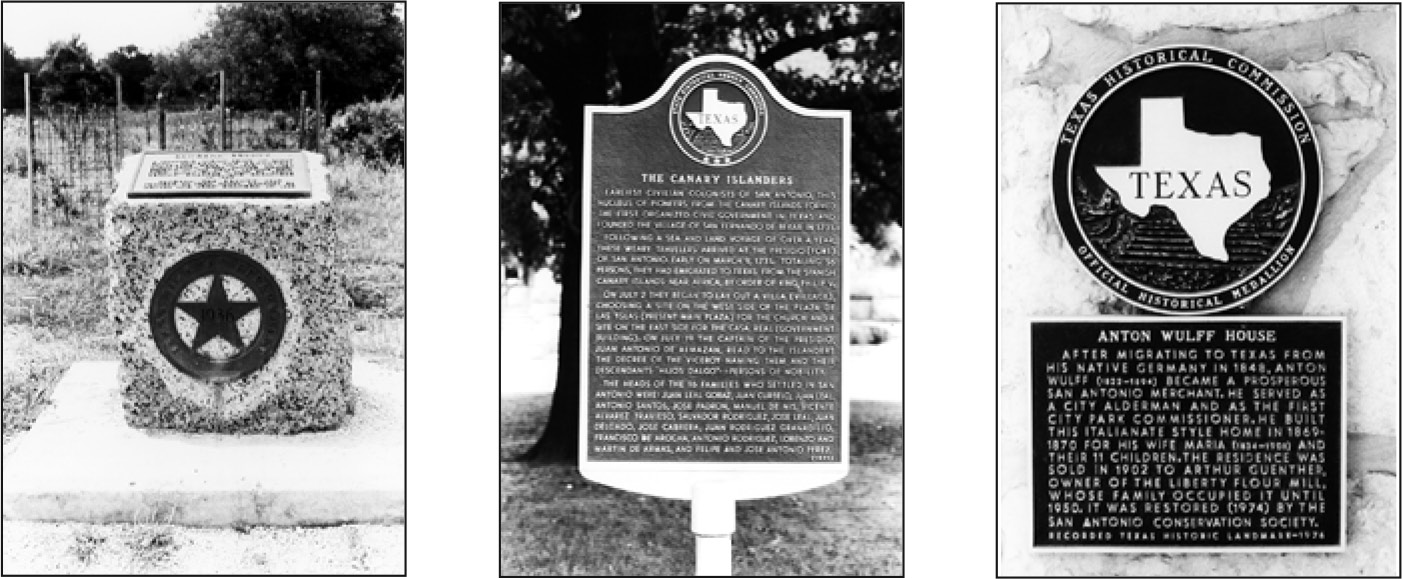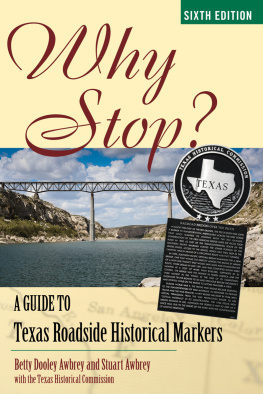Sixth Edition

Taylor Trade Publishing
Lanham New York Boulder Toronto Plymouth, UK


Published by Taylor Trade Publishing
An imprint of The Rowman & Littlefield Publishing Group, Inc.
4501 Forbes Boulevard, Suite 200, Lanham, Maryland 20706
www.rowman.com
10 Thornbury Road, Plymouth PL6 7PP, United Kingdom
Distributed by National Book Network
Copyright 2013 by Taylor Trade Publishing
All rights reserved . No part of this book may be reproduced in any form or by any electronic or mechanical means, including information storage and retrieval systems, without written permission from the publisher, except by a reviewer who may quote passages in a review.
British Library Cataloguing in Publication Information Available
Library of Congress Cataloging-in-Publication Data
Dooley-Awbrey, Betty.
Why stop? : a guide to Texas roadside historical markers / Betty Awbrey and Stuart Awbrey. Sixth Edition.
pages cm
Includes index.
ISBN 978-1-58979-789-5 (pbk. : alk. paper) ISBN 978-1-58979-790-1 (electronic) 1. Historical markersTexasGuidebooks. 2. TexasHistory, Local. 3. LegendsTexas. 4. TexasGuidebooks. I. Awbrey, Stuart, 1937 II. Title.
F387.D68 2013
976.4dc23
2012050584
 The paper used in this publication meets the minimum requirements of American National Standard for Information SciencesPermanence of Paper for Printed Library Materials, ANSI/NISO Z39.48-1992.
The paper used in this publication meets the minimum requirements of American National Standard for Information SciencesPermanence of Paper for Printed Library Materials, ANSI/NISO Z39.48-1992.
Printed in the United States of America

Contents


Dedicated to
The Texas Historical Commission
and all other organizations whose research
and recordings have enriched
our knowledge of the history of Texas.

Acknowledgments
We wish to express our appreciation to the Texas Historical Commission for making its files available and for the courtesy and assistance of its members in compiling this book, especially
Mark Wolfe, Executive Director, Texas Historical Commission
Bratten Thomason, Director, History Programs Division
Bob Brinkman, Marker Program Coordinator
Sarah McCleskey, Historian
and
the staff of the Texas Historical Commission
The Commission maintains an excellent website at www.thc.state.tx.us and has a database of all historical markers at http://atlas.thc.state.tx.us
We also thank the members of the Texas Historical Commission in each of the counties.

About Texas Historical Markers...

The markers you will encounter are designated Official Texas Historical Markers by the Texas Historical Commission. Markers are erected to commemorate historical sites, buildings, and events; institutions such as churches, businesses, and organizations; and individuals whose achievements have been recognized.
The most common types of markers are those pictured. Many of the earlier markers are made of stone, usually granite, featuring either engraved lettering or a metal plate with inscription. The familiar aluminum marker with raised lettering on a black background is more commonly used now. Also, there is the round medallion, which identifies a structure as a Recorded Texas Historic Landmark. An interpretive plate offering historical background of the building often accompanies the medallion.

Preface
From the Panhandle to the Gulf Coast, from Texarkana to El Paso, this vast area that once was a sovereign nation holds an enviable history that intrigues all who are fascinated by its legends. Much of this history endures through the inscriptions on historical markers that recount an array of interesting facts about people, places, and events that shaped the history of this state.
The original purpose of this book was to include the text of markers located along highways and country roads so that hurried travelers could meet the fascinating individuals, experience the dramatic events, and see the historical places of Texas without having to stop to read the markers. That purpose continues with the sixth edition.
When the first edition of Why Stop? was published in 1978, there were more than 6,000 recorded historical markers in Texas. By the time the second edition was published in 1985, that number had increased to nearly 10,000. The Texas Historical Commission (THC) to date has more than 15,000 markers and boasts markers across other southern states, as well as a few Texas markers in Europe.
Each year the THC adds several hundred markers. To accommodate new markers, it is necessary to delete some markers from the book. With each new edition the decision of selecting markers to delete becomes increasingly difficult. During the third revision of Why Stop? the decision was made to feature markers located on more heavily traveled U.S. and state highways without omitting city markers, especially since those markers tell the unique stories of their local history. We also include markers at state parks for their value to the history of Texasjust in case your travel plans do not include a stopping visit until the next time you are in the area.
While the purpose of Why Stop? is to give readers the pleasure of learning about the colorful history of Texas without having to delay a trip, we believe that these inscriptions about the great, near-great, and not-so-great events and people that made this legendary state what it is will inspire you to learn more and maybe even stop awhile. When there is time to stop and read the markers, you will want to go to the courthouse squares, local museums, and city parks where markers are often located. Also, be advised that the historical commissions of many counties publish brochures and have websites that include the locations of the markers in their counties.
Inscriptions on roadside markers are written by the Texas Historical Commission staff, based upon research done by county historical commissions. To the best of our knowledge the inscriptions are quoted as they appear on the markers. Any errors are unintentional, and corrections reported to us will be considered in future editions of Why Stop?











 The paper used in this publication meets the minimum requirements of American National Standard for Information SciencesPermanence of Paper for Printed Library Materials, ANSI/NISO Z39.48-1992.
The paper used in this publication meets the minimum requirements of American National Standard for Information SciencesPermanence of Paper for Printed Library Materials, ANSI/NISO Z39.48-1992.





